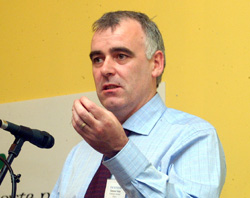20 May 2004 Edition
Pushing all the wrong buttons - The electronic voting fiasco explained

Sinn Féin's Eamonn Nolan
If Noel Dempsey and Martin Cullen worked for a private company, they would not alone have been sacked, but in all likelihood would have been charged with criminal negligence. Contracts were signed for an untested, untried, computer system. Total costs to date have been estimated at upwards of €60 million (Mícheál Martin says that €50 million would allow him open all the unused beds in our hospitals). It appears that there was no clause in the contract guaranteeing payment only on final testing sign off (a standard in any IT contract). And in the face of all the evidence, Martin Cullen continues to insist that everything is cushty!
To be fair, it's not just Dempsey and Cullen who have egg on their faces. If the performance of government in this area is representative of how planning and implementation happen in other areas, then government is in a sorry state. No matter what spin they try to put on it, the interim report from the Commission on Electronic Voting is disastrous for the government. Let's look at the facts.
1. They do not have a final version of the electronic voting system.
2. The version they have has an error in it leading to the incorrect transfer of surplus votes.
3. No final test plan has been agreed.
4. The existing randomisation methods (for mixing of votes before they are counted and distributed) cannot be replicated manually.
5. The Commission recommends that any system should be tested in parallel with a manual count, requiring a change in the randomisation procedure.
One of the key problems detailed by the Commission is with the randomisation, or mixing of votes, achieved in the count centre by dumping their boxes out on tables at random and sorting the votes by hand. The order in which the votes are counted and piled makes no difference to the first count. In later counts, however, votes to be distributed are taken from the top of the relevant piles of votes, so this mixing, or randomisation, at the start plays a key part in determining the result.
The government takes comfort from the fact that the Commission did not reject the electronic voting system on the basis that it doesn't work. That's not much of a comfort though, given that they were unable to determine if it would work as the system is still being modified. You can't test something that is not complete.
The government, however, continue to claim that the system has been rigorously tested. Joe McCarthy, a professional consultant, has gained access through Freedom of Information to government documents in relation to the tests carried out so far. Besides code reviews, which do not involve actually running the software, the department carried out pilot tests in Meath, Dublin North, and Dublin West in the last General Election, and two internal tests run on data from Buncrana UDC and Athy UDC. Information on the Meath test is not available, but based on the four end-to-end tests available, Joe McCarthy points out that:
• Not one of the tests was accurate.
• The actual pilot election in Dublin North had a discrepancy of +1,294 votes.
• The actual pilot election in Dublin West had a discrepancy of -716 votes.
• The internal department test election based on Buncrana UDC had errors in the votes of nine candidates.
• The internal department test election based on Athy UDC had errors in the votes of four candidates.
(Joe McCarthy, Supplementary submission to Commission, April 2004)
Add to this that the limited testing the Commission was able to perform showed an error in the distribution of surplus votes and you have a system that fails to meet any criteria any sane person would set out.
Another plank of the government's publicity has been that electronic voting is successfully used in other much larger countries and therefore should be used here. This argument is based on a distortion of the true situation.
The 26 Counties uses a Proportional Representation — Single Transferable Vote (PR-STV) electoral system. This is a complicated system. The Count Requirements document that the government gave to the software company is 172 pages long, with 35,000 words. The PR-STV system is unlike any of the other systems which use electronic voting currently.
Of course, India can use electronic voting without a hitch. They have a first past the post election, so there are no surpluses to distribute, no ratios to calculate or randomisation to be carried out. In Germany, they also have electronic voting. Here they have a dual system. Every voter has two votes: one for an individual, and one for a party. In both cases it is a simple counting of the number of votes cast; no surpluses to distribute, no ratios to calculate, no randomisation to be carried out. In Brazil, they have a party list system where seats in parliament are allocated based on the number of votes obtained by each party. Again, no surpluses to distribute, no ratios to calculate, no randomisation to be carried out.
Using these countries as examples of the successful implementation of electronic voting is an attempt to mislead the public on the issue.
It is unfortunate that the government have handled the issue of electronic voting so badly. Electronic voting is a good idea. But it needs to be introduced in an open and transparent fashion and developed in a rigorous and formal way. Elections are central to democracy. Every voter has the right to be sure that the system being used is secure and is accurate. The NEDAP PowerVote system the government sought to introduce fails on both counts.


